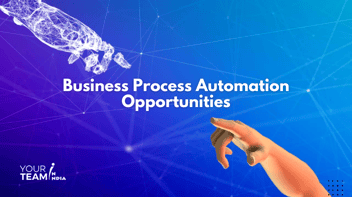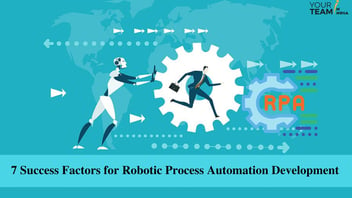In this increasingly customer centric universe, analyzing customer insights to shape products, solutions and buying experience is significant. Mckinsey Research depict, companies leveraging customer behavioral insights outperform competitors by 85%.
The amalgamation of this world is becoming a very complex day by day. The proliferation of data and the desire to stay at the forefront of the competition has prompted companies to aim at data analytics and automation processes for driving strategic business decisions.
The analytics is giving an opportunity to the entrepreneurs to completely understand the dynamics of the business and further anticipate market shifts while tackling risks. It helps while maintaining inventory, pricing solutions and hiring new talent.
Business analytics allow systematic statistical reasoning to make decisions to improve efficiency, risk management, and profits.
Data Analysis and Automation Business Helping Businesses Grow
Implement business automation that requires IT investment to standardize processes.
In order to effectively prioritize resources, you should identify the areas that automation can yield the highest ROI for your company.
This is how data analysis and automation of business processes help businesses to take good decisions.
1) Adapt to the Market Demand

Business process automation and data analytics offer scalability and agility to handle various changes in market conditions.
You don’t have to hire more employees to handle fluctuations in the customer demand or order volume.
For example, the automation process helps you to handle many repetitive tasks so there is no need to hire and train new employees.
You can control costs in a better way and ensure that customers are getting what they desire.
2) More Productivity

Intelligent business process automation helps to enhance productivity at the workplace by automating dull, repetitive tasks while leaving the cerebral work for humans.
Everyone greatly benefits from this technology as the employees don’t have to spend the bulk of their time on unimportant tasks while calibrating data.
Having the technology in play makes sure workers stick to creating tasks while developing an atmosphere of competition in the work environment. This further induces productivity.
3) Less Labor Cost

Many startups pay a lot for hiring employees to perform labor-intensive and time-consuming tasks that don’t add much value to the business.
Data analysis and business automation help reduce the number of employees required to handle tasks while lowering the overhead and increase profitability.
This also allows entrepreneurs to focus on the quality rather than the number of employees. This helps you hire the best talent to fuel growth.
4) Optimize Workforce Allocation

Business process automation software allows you to free up resources from repetitive tasks ensuring you focus on strategic and innovative initiatives rather than manual work.
This process automation software allows you to get the necessary data and analytics that thereby optimize resource allocation.
This ensures that all the team members are working on the right projects and minimize the chances that one person is over occupied while the other is sitting idle all day.
5) Amplifies Marketing ROI

With the help of business process automation tools, the budget can be optimized while improving results.
There so many budget-friendly tools that can be utilized covering email marketing, CRM and sales, audience targeting, etc.
Basically, business automation software helps you process, analyze and organize customer data to implement personalized strategies.
This is the key to improve sales and marketing results in the upcoming years.
6) Leverage Remote Workforce

Companies prefer to hire remote workers while helping businesses access talent and expertise from a different geographical location.
Collaborate with the right outsourcing company and let them work on the projects without the cost of hiring a large team of full-time employees in-house.
During automation processes, employees don’t have to be in the same location in order to work together seamlessly.
There are certain businesses that can even go completely virtual, saving on overhead like rent, office equipment, etc.
7) Improves Collaboration

To make sure that complex projects become successful, it is important that you monitor team member’s responsibility to make sure there is proper flow of information as well as clear communication.
Best analytic platforms help you track the project process, communicate key dates and milestones.
This keeps the team members updated with the latest data, files and project status for seamless collaboration.
8) Facilitate Customer Support

Various customer support technologies like help desk software and chatbots can streamline customer support and improve their satisfaction.
Chatbots help in process automation and can handle basic queries while giving links regarding essential information. The major benefit is, customers don’t have to wait for a human to reply.
9) Understand Areas of Improvement

To boost your ROI with the help of a business automation workflow, first identify your weakness and time-consuming segments.
With the help of Artificial Intelligence, fix key areas that require improvement by examining gap analysis.
In certain cases, existing systems and processes may have to be altered to incorporate with Artificial Intelligence.
Integrating old data with new ones can take time but once done, the productivity and ROI will exponentially increase.
It may take a while to integrate old databases with new AI systems, but once you do, your productivity and ROI will increase exponentially.
10) Ensure Compliance

For startups, adhering to government and industry regulations like tax compliance, reimbursement, etc. can be a costly affair.
With process automation, you can make sure employees follow specific procedures complying with industry standards and regulations. Incorporating rules in the workflow also ensures the necessary criteria are met.
11) Make most of your consumer pattern

In this customer-oriented era, companies have amassed a wealth of consumer information.
To stay competitive, it is important for companies to use consumer insights to shape solutions.
A comprehensive understanding of customers through business intelligence and analytics gives an insightful narrative regarding customer preferences.
For example, a company can understand its customers and understand the web presence, know the bounce rate, returning visitors, etc. Know, what are formats are likely to have a powerful impact on key consumer segments.
12) Helps Drive Performance

While companies spend a good amount of time analyzing consumer data and frontline monetization opportunities, it is important to focus on performance
Data analytics solutions play a major role in decreasing inefficiency while streamlining business operations.
For example, reporting and analytical dashboards can identify data correlation giving you detailed insights to perform cost valuations and pricing segmentation.
Also, using business intelligence analytics helps in measuring the key performance metrics across different areas like operational excellence, product innovation, and workforce planning. This solves complex business scenarios.
13) Risk Management

Today, companies are exposed to high risk from structured data. By leveraging risk analytics, businesses can find themselves in a better position to quantify, measure and predict risk.
Smart analytics is an enterprise-wide approach that should develop ways to pull data across various levels into a central platform.
By measuring the risk beforehand, it will help them make a better decision and predict likely scenarios.
How to Utilize Data Analytics Software to Make Business Decisions?
Initially, it is good to start with a plan of action that details how you will find the data you require. And most importantly, interpret it to make business decisions.
Follow these five-step process to get started:
Step 1: Consider Your Objectives and Priorities
Any decision that you make should be profitable for your business. So start by asking: what goals are your priorities?
Start with the most important ones.
Step 2: Present Relevant Data
Once the priorities are identified, it is now time to consider the relevant data. The word ‘relevant’ is key here.
With the help of a data analytics platform, you don’t have to spend hours analyzing the data. Keep the data relevant and collect the one that is relatable to your objective.
You can find relevant data in these sources:
- Website analytics
- CRM software
- Business intelligence process platform
- Customer feedback
Customer feedback is very important because 60% of firms feel that taking the help of customer feedback as a part of the decision making process results in a successful project.
Step 3: Draw a Conclusion from the Data
Have a close look at the data you have collected and try identifying the pattern or trend.
Take a look at the historical data you’ve collected and try to identify patterns or trends.
For data-driven decision-making companies, it is critical that they look into their historical data to see if there is some indication that any rewrite will be better.
Throughout this process, consider:
- Rewriting the onboarding sequence in the past proved to have a positive improvement.
- Humorous social media posts get the highest engagement from the customers.
- The maximum number of people visiting your customer care are already existing customers but the onboarding sequence doesn’t direct new users.
- In that scenario, rewrite your onboarding sequence as it will be a safe bet and a smart decision. Now compare this to a non-data-driven decision-making example.
You want to reduce the churn and want to rewrite the onboarding sequence. Rather than having a look at the historical data, you can update the copy while keeping the same tone and direct users to the web pages.
Suppose, there is still no difference in the churn rate after a few weeks. Then, you should realize that the email sequence is not the problem but something else. So, you should move ahead.
Are you able to understand the difference here?
Now, with the help of enterprise data analytics, everything becomes hassle-free. These approaches and solutions are a lot more successful.
Step 4: Plan a Strategy
You have finally found the goal and the best data analytical solution, move ahead with the new strategy.
The next step is to create a plan of action so that your decision is put into practice.
The goals have to be clearly defined to ensure what has to be done, why and when. Knowing the outcome is also important. Never have unrealistic expectations.
You should take the help of a real-time data platform to conclude if it will help with customer loyalty.
Step 5: Measure Success
The best analytics platform helps in taking the right decision. Congratulations!
But that doesn’t define the decision-making process.
Have a look at your original data that you initially collected. Then compare that data with the new data.
Did the advanced analytical platform have a positive impact on your business?
Was this decision successful? Yes? Congratulations.
Finally, you know what works and what doesn’t.
Leap Worth Taking
Implementing business process automation and data analytics in your business is worth investing in.
By decreasing the human workload exponentially and expanding weaker areas in your business plan, the intelligent automation process offers you with a series of solutions.
This further amplifies your bottom line and keeps your employees focused on high-value work.







